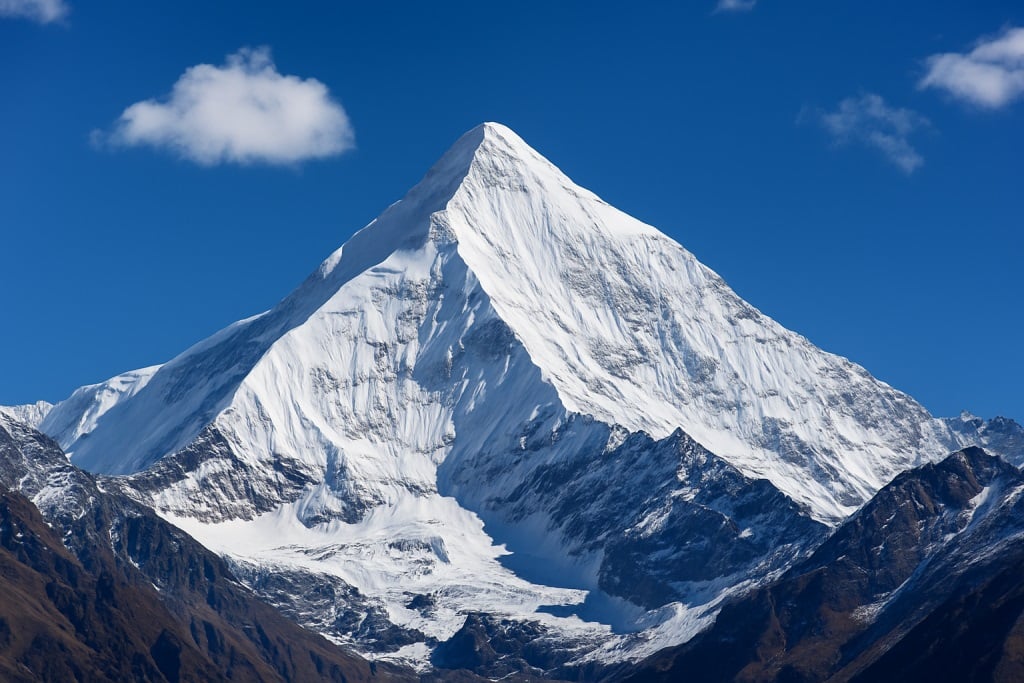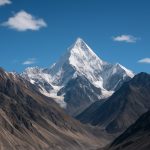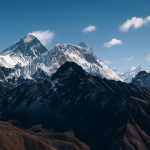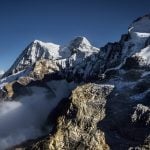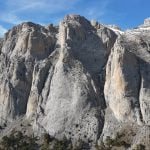Mount Trisul I: Peak of the Kumaon Himalayas
Trisul I, standing at 7,120 meters (23,359 feet), is the highest among the three peaks that form the Trisul massif located in the Kumaon Himalayas of Uttarakhand, India. Situated southwest of the famed Nanda Devi Sanctuary, Trisul I is renowned both for its early mountaineering history and its technical climbing challenges. It holds the distinction of being the first mountain over 7,000 meters to be successfully climbed, achieved by a British expedition led by T.G. Longstaff in 1907. Mount Trisul I: Peak of the Kumaon Himalayas
Geographical and Technical Characteristics
Trisul I’s topography consists of steep snow-covered faces, extensive glacier systems, and rugged rock ridges. The massif overlooks the Ronti Glacier and lies close to peaks like Nanda Ghunti. Its distinct triangular profile is a recognizable feature of the region.
Climbing Trisul I requires navigating long glacier approaches, crossing avalanche-prone zones, and ascending steep, crevassed ice fields. The final summit ridge presents challenges such as sharp cornices and exposure to strong winds. The standard route involves an approach via the Ronti Saddle and the northeast ridge, requiring a multi-day expedition involving glacier travel, high-altitude camps, and technical snow climbing skills.
Climbing and Weather Conditions
Weather on Trisul I is typically harsh, with strong winds, sub-zero temperatures, and frequent snowstorms even during the climbing season. Rapid weather changes are common, demanding flexible expedition planning and careful acclimatization strategies.
The best time for attempting a climb is between May and June (pre-monsoon) and September to October (post-monsoon). However, the mountain’s proximity to the monsoon-affected regions means climbers must be prepared for sudden snow accumulation and deteriorating conditions.
Access and Permits
Access to Trisul I starts from Munsiyari or Lata villages, followed by a trek through the Ronti Glacier or Sunderdhunga Valley. Expeditions must register with the Indian Mountaineering Foundation (IMF), and climbers require special permits for attempting the peak due to its proximity to protected areas.
The base camp setup typically occurs near the glacier snouts, and further camps are established at intermediate elevations for acclimatization before the final summit push.
Conclusion
Trisul I stands as a technically demanding and historically significant objective in the Indian Himalayas. Its combination of steep alpine conditions, unpredictable weather, and historic legacy makes it a prized target for experienced mountaineers seeking a serious but attainable 7,000-meter peak.
Where is Trisul I located?
Trisul I is located in the Kumaon Himalayas in Uttarakhand, India. It lies to the southwest of the Nanda Devi Sanctuary and is part of the Trisul massif, which consists of three prominent peaks.
What is the elevation of Trisul I?
Trisul I stands at 7,120 meters (23,359 feet) above sea level, making it the highest peak of the Trisul massif.
When was Trisul I first climbed?
The first successful ascent of Trisul I was achieved in 1907 by a British expedition led by T.G. Longstaff, making it the first mountain over 7,000 meters to be climbed.
What are the main technical challenges of climbing Trisul I?
Climbers face several technical challenges on Trisul I, including steep glacier faces, avalanche-prone slopes, and crevassed ice fields. The final summit ridge is exposed and requires navigating sharp, corniced ridges. Additionally, unpredictable weather and extreme altitudes make the climb more demanding.
What is the standard route for climbing Trisul I?
The standard route to Trisul I involves an approach via the Ronti Saddle and the northeast ridge. This route requires several high-altitude camps, including a base camp at the base of the Ronti Glacier. Climbers must ascend steep snow and ice slopes, using fixed ropes and ice protection.
What is the best time to climb Trisul I?
The optimal time for attempting Trisul I is pre-monsoon (May to June) and post-monsoon (September to October). These months offer relatively more stable weather conditions. However, even during these windows, the weather can be unpredictable, with snowstorms and rapid temperature drops common.
Is it difficult to access Trisul I?
Yes, accessing Trisul I is difficult. The trek to the base camp starts from Munsiyari, a remote village, and takes several days to reach the glacier. The path is challenging, with no road access, and requires a multi-day hike across difficult terrain. Porters or pack animals are typically used for carrying gear.
Are special permits required to climb Trisul I?
Yes, special permits are required to climb Trisul I. Climbers must obtain permissions from the Indian Mountaineering Foundation (IMF), as well as clearances from the local authorities, due to the peak’s location near protected areas and sensitive borders.
What are the key hazards during an ascent of Trisul I?
Key hazards include avalanche risk, crevasses, and unpredictable weather conditions. Climbers must be prepared for strong winds, whiteout conditions, and high-altitude sickness due to the mountain’s elevation. Careful acclimatization is required.
How experienced should climbers be to attempt Trisul I?
Climbers should have advanced mountaineering skills and experience with high-altitude expeditions, including glacier navigation and ice climbing. Previous experience on similar technical peaks, such as Nanda Devi or Kangchenjunga, is highly recommended.

